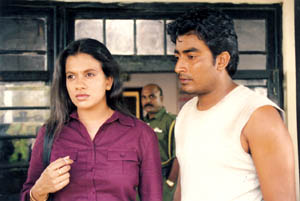|
Film review:
Sankranthiya signifies conflicting human relations
Dr. Senarath Tennakoon
|

STILL: Sangeetha Weeraratne and Bimal Jayakody in a scene from
Sankranthiya
|
CINEMA: Sankranthiya of Anurudda Jayasinghe is a faithful
creation based on the script of Professor Nimal Senanayake. The
narrative is complete in its component parts like the setting,
characters, actions, events, conflict and resolve.
The vividity of the social setting is sacrificed to two restricted
situations, the natural environment around the Mahakandarava tank and
the colonial type mansion.
The key characters are limited to three - the bearded old animal
scientist/anthropologist type professor who always makes use of
animal/monkey behaviour to elucidate human behaviour; his young and
pretty wife entangled in a sensational conflict and his young energetic
support assistant who helps in his research studies.
The human relationships of these three characters are portrayed
through powerful signifiers. In particular the language used by the
professor teeming with puns, his searching movements and his queer trap
of his feigning to be lost in the wood signify his suspicious character
woven around his pretty young wife.
The assistant on the other hand playing his guitar beside the bonfire
on the bund of the vast tank at night while the professor’s wife makes
advances towards him are quiet subliminal expressions.
W. Jayasiri, Sangeeta Weeraratne and Bimal Jayakody quite efficiently
perform their respective roles in particular in the final conflict
resolving shot sequencing. The audience may identify themes like
educational power, authority, alienation, ambiguity, sexuality and
boredom in varying degrees associated with the three characters.
The gaze of the audience will not be uniform. The editing of the film
has ensured continued flow of visual images, despite jump cuts by
darkening have marked the relationships as well are the boundaries of
the visual messages.
At one time, the audience will be sympathetic towards all the three
characters. At another time the audience will take the side of the
pretty young wife and the focus of sympathy would be on the young
assistant. In the end the old man has to die perhaps disproving the
Freudian philosophy.
Sankranthiya is not a closed film although there is a beginning and
an apparent ending. But the end is yet another beginning. The creators
of this film have been faithful to the narrative style without searching
for new approaches in its presentation.
But this approach has not impeded authenticity. It is neither an
entertainment film nor a serious film. There are no songs and dances as
in a popular Hindi film. But it is not devoid of a lyrical tenor. There
is cultural mixing.
Tradition is not completely lost. The cottage keeper worships God
Aiyanayaka at the news of the professor’s sudden disappearance, while
the assistant informs the police. Finally the question arises as to the
meaningful content of this creation. Is there a penetrative insight into
the social order or human life?
Well, adopting a post-modernistic view the audience will fail to
identify a single definitive meaning or a sublime reality inculcated by
it. Instead this creation stimulates and impinges on the imagination of
the audience to appreciate and extract a variety of meanings and
conclusions.
In Sri Lanka movie attendance is continuing to decline and the
television has become a way of life.
However, knowing well that the fate of the struggle to regain the
movie audiences from the television, it is heartening to appreciate the
enthusiasm of dedicated new talented creators for their interest in the
cinematic medium. Before the advent of the television the movie was
undoubtedly our way of life.
Sankanthriya would not be an economically successful boxoffice film
with any impact on our popular culture.
But because of the polarised status of the population, there would be
some selective strata of viewers who would like to see new films
carrying different view points. In particular the positioning of the
audience towards Sankranthiya would generate a discourse on it. |

